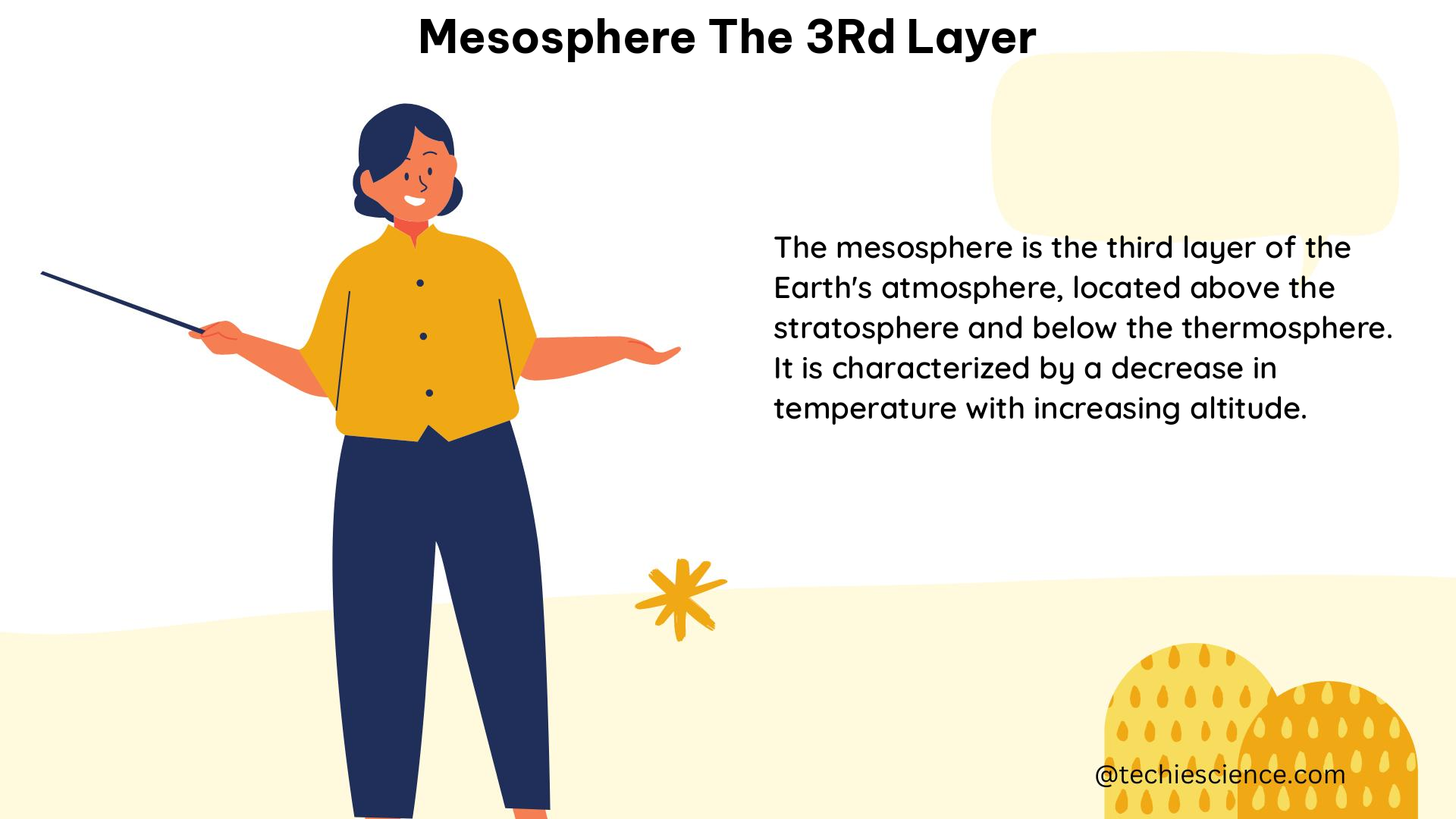The mesosphere is the third layer of the Earth’s atmosphere, located above the stratosphere and below the thermosphere. It extends from approximately 50 to 90 kilometers above the Earth’s surface, playing a crucial role in various atmospheric phenomena and processes.
Characteristics of the Mesosphere
Temperature Profile
- In the mesosphere, temperature decreases with increasing altitude, reaching a minimum of about -90°C at the “mesopause,” which is the boundary between the mesosphere and the thermosphere.
- This temperature decrease is due to the absorption of solar radiation by ozone (O₃) in the stratosphere, which heats the lower atmosphere, and the lack of significant heat sources in the mesosphere.
Composition and Structure
- The mesosphere is primarily composed of nitrogen (N₂) and oxygen (O₂), with trace amounts of other gases such as carbon dioxide (CO₂), water vapor (H₂O), and methane (CH₄).
- The density of the atmosphere decreases exponentially with altitude, with the mesosphere being much less dense than the lower atmosphere.
- The mesopause, the boundary between the mesosphere and the thermosphere, is characterized by a sharp temperature inversion, where the temperature begins to increase again.
Atmospheric Phenomena
- Meteor Burning: The mesosphere is the layer where most meteors burn up upon entering the Earth’s atmosphere. This is due to the high-speed collisions between meteoroids and the molecules in the mesosphere, which cause the meteoroids to heat up and disintegrate.
- Noctilucent Clouds: These thin, wispy clouds form in the mesosphere during the summer months and are visible at night. They are composed of ice crystals and are the highest clouds in the Earth’s atmosphere.
- Polar Mesospheric Summer Echoes (PMSEs): These phenomena occur when radio waves bounce off the charged particles in the mesosphere, which are created by the interaction between solar radiation and the atmosphere.
- Atmospheric Gravity Waves: These waves are generated in the troposphere and propagate upward into the mesosphere, where they can interact with the background wind and temperature structure, leading to the formation of various atmospheric phenomena.
Importance of the Mesosphere
- Climate and Weather Studies: The mesosphere is an important region for studying the Earth’s climate and weather patterns, as it is the layer where many atmospheric phenomena occur.
- Magnetic Field and Charged Particles: The mesosphere is where the Earth’s magnetic field lines converge, trapping charged particles and creating the Van Allen “radiation” belts. This makes the mesosphere an important region for studying the Earth’s magnetic field and the behavior of charged particles in the atmosphere.
- Atmospheric Dynamics: The mesosphere is a crucial layer for understanding the dynamics of the Earth’s atmosphere, as it is the region where various atmospheric processes, such as the propagation of gravity waves and the formation of noctilucent clouds, take place.
Studying the Mesosphere

Challenges
- The mesosphere is a challenging layer to study due to its high altitude and the harsh conditions that exist there, such as extremely low temperatures and low atmospheric density.
- Direct in-situ measurements in the mesosphere are difficult to obtain, as the region is beyond the reach of most conventional aircraft and balloons.
Measurement Techniques
- Rockets: Sounding rockets are used to launch instruments into the mesosphere, allowing for direct measurements of various parameters, such as temperature, pressure, and chemical composition.
- Balloons: High-altitude balloons can reach the lower regions of the mesosphere, providing valuable data on atmospheric conditions.
- Lidars (Light Detection and Ranging): These remote sensing instruments use laser beams to measure various atmospheric properties, such as temperature, wind, and the presence of aerosols and clouds, in the mesosphere.
- Satellite Observations: Satellites equipped with specialized instruments can provide global-scale measurements of the mesosphere, including temperature, composition, and the occurrence of atmospheric phenomena.
- Ground-based Observations: Ground-based instruments, such as radars and spectrometers, can be used to study the mesosphere by detecting and analyzing various atmospheric signals, such as PMSEs and noctilucent clouds.
Numerical Modeling
- Sophisticated computer models, such as general circulation models (GCMs) and chemistry-climate models, are used to simulate the complex processes and interactions within the mesosphere, allowing for a better understanding of its role in the Earth’s atmospheric system.
- These models incorporate various physical, chemical, and dynamical processes to provide insights into the mesosphere’s behavior and its interactions with other atmospheric layers.
Advances in Mesospheric Research
Improved Measurement Techniques
- Advancements in rocket, balloon, and lidar technologies have enabled more accurate and detailed measurements of the mesosphere, leading to a better understanding of its physical and chemical properties.
- Satellite-based observations have provided a global perspective on mesospheric phenomena, allowing for the study of large-scale patterns and trends.
Numerical Modeling Improvements
- Continuous advancements in computational power and the incorporation of more detailed physical and chemical processes have led to the development of increasingly sophisticated numerical models of the mesosphere.
- These models have improved our ability to simulate and predict the behavior of the mesosphere, including its response to various natural and anthropogenic forcings.
Interdisciplinary Collaboration
- The study of the mesosphere requires the integration of knowledge from various scientific disciplines, such as atmospheric physics, chemistry, and meteorology.
- Collaborative efforts among researchers from different fields have led to a more comprehensive understanding of the mesosphere and its role in the Earth’s atmospheric system.
Conclusion
The mesosphere, the third layer of the Earth’s atmosphere, is a crucial region for understanding the Earth’s climate, weather patterns, magnetic field, and the behavior of charged particles in the atmosphere. Despite the challenges associated with studying this high-altitude layer, scientists have developed various tools and techniques to measure and analyze its properties, leading to significant advancements in our understanding of the mesosphere and its role in the Earth’s atmospheric system.
References:
- Mesosphere – an overview | ScienceDirect Topics. (n.d.). ScienceDirect. Retrieved June 18, 2024, from https://www.sciencedirect.com/topics/earth-and-planetary-sciences/mesosphere
- Long‐term changes in the mesosphere calculated by a two … (2005). AGU Journals. Retrieved June 18, 2024, from https://agupubs.onlinelibrary.wiley.com/doi/full/10.1029/2003JD004410
- Mesosphere – an overview | ScienceDirect Topics. (n.d.). ScienceDirect. Retrieved June 18, 2024, from https://www.sciencedirect.com/topics/chemistry/mesosphere
- The Mesosphere – UCAR Center for Science Education. (n.d.). UCAR Center for Science Education. Retrieved June 18, 2024, from https://scied.ucar.edu/learning-zone/atmosphere/mesosphere
- Layers of the atmosphere – NIWA. (n.d.). NIWA. Retrieved June 18, 2024, from https://niwa.co.nz/atmosphere/layers-atmosphere

Hi, I am Sanchari Chakraborty. I have done Master’s in Electronics.
I always like to explore new inventions in the field of Electronics.
I am an eager learner, currently invested in the field of Applied Optics and Photonics. I am also an active member of SPIE (International society for optics and photonics) and OSI(Optical Society of India). My articles are aimed at bringing quality science research topics to light in a simple yet informative way. Science has been evolving since time immemorial. So, I try my bit to tap into the evolution and present it to the readers.
Let’s connect through